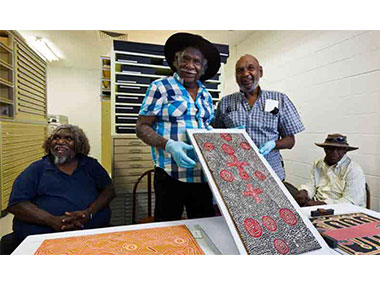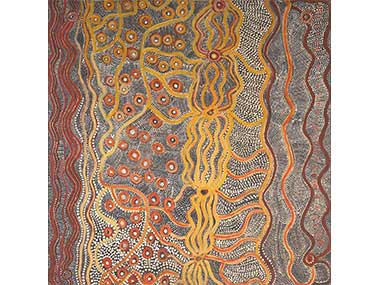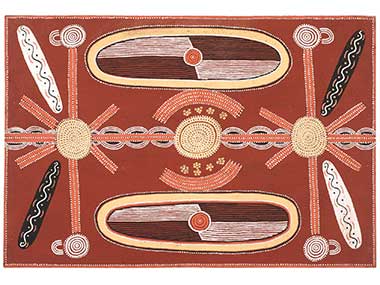TJUNGUṈUTJA - from having come together

Four of the co-curators of Tjunguṉutja - Bobby West, Long Jack Philipus, Sid Anderson and Michael Nelson Jagamarra - enjoy rediscovering the Papunya boards. Photo by Amos Aikman, (News Ltd)
Posted by Jeremy Eccles | 05.07.17
Gallery: Museum and Art Gallery of the Northern Territory
Dates:
01.07.17
: 18.02.18
“The efflorescence of imagery that struck in the hothouse conditions of the Men’s Painting Room will never be repeated, for these works were created at the moment when the epic songlines that connect Aboriginal Australia were unveiled”.
John Kean should know about the events that produced the “founding documents of Aboriginal art” at Papunya in 1971/2 as he was the Art Adviser to Papunya Tula Artists from 1977 to 79 and is now researching the lives and work of four of those founding fathers.
Right now, the rest of us are getting a rather better idea of that efflorescence than has been possible before as the Museum & Art Gallery of the Northern Territory (MAGNT) has put on show in Darwin 128 of the earliest painted boards from that hothouse time. The Gallery actually has some number between 207 and 226 (reports vary) of the earliest one thousand or so paintings depicting the ceremonial lives of some 25 courageous Aboriginal men, all on scraps of discarded building materials. For another courageous man, Colin Jack-Hinton, who'd only taken over as Director of the then buildingless MAGNT in 1970, began buying the boards in March 1972, having identified them immediately as “highly significant works”.
Jack-Hinton was alone in this view amongst Australian institutional leaders, though the SA Museum bought a few, presumably with ethnographic interest. The market was equally underwhelmed – a pioneering Sydney exhibition at David Jones store in May 1972 sold just two boards, while Keith Namatjira, in the watercolour tradition, sold six. And sales were still going so badly in 1973 that an accountant auditing the nascent Papunya Tula Artists Company saved 100 boards from being burnt for a pittance. Now, prices have topped $400,000 for a single Johnny Warangkula board in recognition that “the last great art movement of the 20th Century” (apocryphally, the assessment of Robert Hughes) had been thrust into being by these works.
And one of the matters clarified by this show called Tjunguṉutja: from having come together is that it was really the hunger and determination of the artists to get the complexity of their culture out into the world that brought it off, not simply the heroic drive of one white man, Geoffrey Bardon.
For Luke Scholes, one of its co-curators and another former PTA employee, has researched new sources of information in the NT Government archives to find other white facilitators who played their part and who reported on the fragility of Bardon's role as he came and went from the remote community, set up to assimilate desert Aborigines into a non-Indigenous future rather than encourage them to fight for their unique and ancient identity through their art.
Scholes sums Bardon's role up in the words of Fred Friis, headmaster of the school that took this wandering teacher in when he painted an Aboriginal family scene on the wall that would later be the site of the legendary Honey Ant Dreaming painting by Aboriginal men: “It took a fella like Geoff to come along and turn things on their head....he set the agenda”. But Scholes believes that Bardon's many, post-Papunya tellings of the story have tended to achieve “the force of a Dreaming narrative itself”. And that narrative left Friis, who bought Masonite boards for the artists out of school funds when Bardon went missing; Jack Cooke, the District Welfare Officer who sold the first boards in Alice Springs; Mary White, a vital link with bodies like the Australia Council's Aboriginal Arts Board in Sydney; Warren Smith, another District Welfare Officer, who encouraged any sort of Aboriginal income-earning; Laurie Owens, the Papunya Superintendent who allocated an Arts Centre and shepherded PTA into being, all out of the picture. Meanwhile, both NT and Canberra government departments, which Bardon paranoidly believed were trying to take control of “my art”, proudly collected the new works.
And many were sold by Pat Hogan of the legendary Stuart Gallery, based in an Alice Springs caravan park, who gained exclusive access to the early boards through her enthusiasm for the art and its meaning - as well her cash flow. When Bardon departed for the Chelmsford Psychiatric Hospital in July 1972 after just 17 days as the Artistic Director he'd wanted to be, Hogan became PTA's Co-ordinator, though problems were set in store for the future of these 'founding documents' for, as a woman, she couldn't be given any explanations of an artwork's story, sometimes not even being told its title.
And here we run into one of the major reasons why it's taken until 2017 for these 45/6-year-old works to come back into public view. Put simply, attitudes towards these early revelations of ceremonial life have changed. Uncertainty reigned for many years this century, after the commercial discovery of the art at auction in the 90s and the Art Gallery of NSW's uncensored showing in Papunya Tula: Genesis and Genius in 2000.
Now there's fear that “vulnerable people from the relevant Indigenous communities” (in anthropologist Dick Kimber's words) may see “something that doesn't belong to us”, as one of the curators put it - which justifies why, now, the co-curators of Tjunguṉutja are all senior Desert men – namely, Long Jack Philipus Tjakamarra, Michael Nelson Jagamarra, Bobby West Tjupurrula, Sid Anderson and Joseph Jurrah Tjapaltjarri. The first four – two of the surviving early painters (Philipus and Nelson) and the son of one (West), plus Anderson, who's descended from Old Bert Tjakamarra, is one of the senior men in Papunya who approved the start of the painting movement and is himself a senior figure in desert culture who declines to paint – were brought in in 2012 when an exhibition in America carelessly sought to reveal both the art and its original, often mistaken interpretations by Bardon and Hogan. The MAGNT boards, it was decreed, needed strict checking by contemporary cultural custodians. Jurrah, the artist son of Charlie Tjaruru Tjungurrayi, the first PTA artist to have a solo show, has joined the current exercise as the health and memories of the older artists fade. Tribal balance and a balance between those who stayed at 'Papunya end' and the Pintupi who departed for their tribal lands further west and became the 'Kintore mob' has been maintained.
It is they who have declared that 63 MAGNT boards are 'restricted'. But they've also confirmed that the paintings grew from the need by the recently arrived Pintupi at Papunya to prove they had 'strong law' in a series of Tingarri ceremonies in 1970. This ceremonial challenge – with body painting - was followed by the Honey Ant mural that brought the painters “all together”. In the exhibition's catalogue, we learn that, following the opening of the Yuendumu Men's Museum up the Tanami Track on 31st July 1971 - a seminal event as it brought ceremonial images and tjuringa in from distant sacred sites (in the form of murals) to a community where tribal men now accepted they'd have to live – one of the Papunya artists who'd been there, Kaapa Mbitjana Tjampitjinpa, went bush and recovered a Honey Ant tjuringa and brought it into his community.
The rest, as they say, is history.
But then, it's the rapid progress of the new 'art' from “awkward icons to virtuosic landscape painting in the most complete Humboldtian sense” (as John Kean dramatically claims) that makes the unveiling of all this “dynamic heterogeneity” in one place so exciting. He cites Johnny Warangkula's 1971 'Rain, Lightning and Stars at Night' which doesn't just map country but “augments it with contrapuntal evocations of soil and vegetation, hydrology and fire history” to justify his claim. For good measure, Kean adds an assessment, 'post-Impressionist vitality”!
And look how happy the Aboriginal co-curators were when they encountered this treasure trove! As Sid Anderson puts it: “When I saw the old men’s paintings, they just hit me [thumps chest]; they hit me in my heart and I just accepted them as my own. They are a gift from those old men and they came into my body like a soul. The feeling it gave me enabled me to look at them with confidence. When you see these paintings you see your Country, the Country that’s been sung by your father, your grandfather, kurtungurlu. They sing that Country over and over again so it sticks in your head”.
One person who won't be in Darwin to share that hit in the heart is Peter Fannin, who died last month. He was a fellow teacher in Papunya who shared a house with Geoff Bardon, and who took over from Pat Hogan in working with the artists through Papunya Tula. Significantly, he turned them to canvas as a longer lasting, and more transportable medium for their art. He subsequently sold his collection of early boards to the National Gallery for a million dollars, setting up a fund for the artists' families with much of it.
And Fannin's assessment of Geoff Bardon: “The fact of the matter is, he was a wonderful visionary but he was not the person to get the show on the road. That turned out to be me and two others, Bob Edwards, director of the Aboriginal Arts Board and the very important Kaapa Tjampitjinpa”.
Tjunguṉutja: from having come together will be on show at the Museum in Darwin for eight months, and then have a well-earned rest, says Luke Scholes. With plans afoot to open an 'Iconic Art Gallery' in Alice Springs, it would seem appropriate that the boards are next seen there. “That would certainly please my co-curators!”.
URL: http://www.magnt.net.au/tjungunutja
Share this:
»  del.icio.us
»
del.icio.us
»  Digg it
»
Digg it
»  reddit
»
reddit
»  Google
»
Google
»  StumbleUpon
»
StumbleUpon
»  Technorati
»
Technorati
»  Facebook
Facebook
Contact Details
Gallery: Museum and Art Gallery of the Northern Territory
Contact: Marcus Schutenko
Email: info@magnt.net.au
Telephone: +61 8 8999 8264
Address: 19 Conacher Street Fanny Bay 0820 NT
Gallery: Museum and Art Gallery of the Northern Territory
Contact: Marcus Schutenko
Email: info@magnt.net.au
Telephone: +61 8 8999 8264
Address: 19 Conacher Street Fanny Bay 0820 NT

Johnny Warangkula's "virtuosic landscape", 'Rain, lightning and stars at night' (1971), synthetic polymer paint on compressed fibre board.

An early Kaapa Tjampitjinpa board showing ceremonial objects, 'Man travelling' (1972), synthetic polymer paint on compressed fibre board
Where is the exhibition?
Further Research
Gallery: Museum and Art Gallery of the Northern Territory
Artists: Bobby West Tjupurrula | Charlie Tjaruru Tjungurrayi | Johnny Warangkula | Joseph Jurrah Tjapaltjarri | Kaapa Mbitjana Tjampitjinpa | Keith Namatjira | Long Jack Philipus Tjakamarra | Michael Nelson Jagamarra | Old Bert Tjakamarra
News Tags: Colin Jack-Hinton | Geoffrey Bardon | Jeremy Eccles | John Kean | Luke Scholes | MAGNT | Papunya boards | Papunya Tula Artists | Peter Fannin | Tjunguṉutja
News Categories: Australia | Blog | Exhibition | Feature | Industry | News
Exhibition Archive
- 10.10.17 | TARNANTHI 2017
- 11.08.17 | Natsiaas 2017
- 20.07.17 | APY ART DOMINATES THE WYNNE
- 17.07.17 | Anangu Artist Wins $100,000 Prize
- 14.07.17 | The End of AAMU
- 11.07.17 | ART ACROSS THE COUNTRY
- 11.07.17 | TARNANTHI IN OCTOBER
- 05.07.17 | TJUNGUṈUTJA - from having come together
- 13.06.17 | Ghost-Nets Straddle the World
- 07.06.17 | Grayson Perry Going Indigenous?
- 05.06.17 | Barks Bigger than Ben Hur
- 27.05.17 | NGA QUINQUENNIAL 2017
- 21.05.17 | Blak Douglas Finds Home at the NGA
- 21.05.17 | BRIAN ROBINSON WINS HAZELHURST WOP
- 18.05.17 | PARRTJIMA 2.0
Advertising

